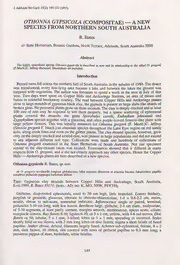Table Of ContentJ. Adelaide Bot Gard. 15(2): 149-151 (1993)
OTHONNA GYPSICOLA (COMPOSITAE) 4 A NEW
SPECIES FROM NORTHERN SOUTH AUSTRALIA
R. Bates
c/- State Herbarium, Botanic Gardens, North Terrace, Adelaide, South Australia 5000
Abstract
The highly specialised species Othonna gypsicola is described as new and its relationship to the allied O. gregorii
(F.Muell.)C. Jeffrey discussed. Illustrations are included.
Introduction
Record rains fell across the northern half of South Australia in the autumn of 1989. The desert
was transformed; every low-lying area became a lake and between the lakes the ground was
carpeted with vegetation. The author was fortunate to spend a week in the area in July of that
year. Two days were spent on Copper Hills and Arckaringa Stations, an area of mesas and
buttes in colourful breakaway country. The road between Copper Hills and Arckaringa passes
close to large mounds of gypseous black clay, the gypsum is present as large slabs like shards of
broken glass. No perennial plants grow on these mounds. The clay is deeply cracked and at least
100 mm of rain may be required to wet them properly, but a sparse scattering of ephemeral
plants covered the mounds: the grass Sporobolus carolii, Embadium johnstonii and
Zygophyllum species together with a glaucous, and often purple-leaved Senecio-like plant with
large yellow flowers. This was initially mistaken for Othonna gregorii (F. Muell.)C. Jeffrey
(Senecio gregorii F. Muell.) an abundant species throughout the Lake Eyre region on red sandy
soils, along creek lines and even on the gibber plains. The clay-mound species, however, grew
only on the deeply cracked and eroded clay, was present in large populations and did not extend
to any adjacent different soil type. Collections were made and hundreds of collections of
Othonna gregorii examined in the State Herbarium of South Australia. Not one specimen
similar to the clay-mound taxon was located. Examination showed that it differed in many
respects from O. gregorii, and it did not closely approach any other species. Hence the Copper
Hills 4 Arckaringa plants are here described as a new species.
Othonna gypsicola R. Bates, sp. nov.
ab O. gregorio involucello longiore globulariore, lobis expansis discorum et acheniis fuscatis falcatioribus papillis
serialibus pellucidis pappoque barbellato differt.
Type: Gypseous clay mounds between Copper Hills and Arckaringa, South Australia,
8.vii.1989, R. Bates 19171; (holo.: AD; iso: K, MO, NSW, PERTH).
Glabrous, deep-rooted ephemerals, erect to 30 cm high, little branched. Leaves leathery,
purplish or greenish, glaucous, obovate to obovate-oblanceolate, 1-4 x 0.8-2.2 cm, entire,
sessile, obtuse to sub-acute, somewhat imbricate. Inflorescence single or paired, terminal;
peduncles 3-10 cm long, with few leaves. Involucre large, globular, 2-4 cm diam., ecalyculate,
of 5-10 segments, at least partly connate, margins smooth, membranous, apices acute, ciliate;
receptacle convex. Ray florets 8-10; ligules 6-10, ca 3 x 1 cm, yellow, with 4-6 red nerves. Disc
florets ca 50, tubular, 5 x 1 mm, 5-lobed; lobes ca 1 x 1 mm, spreading or recurved. Styles
shortly bifid on ray florets, with 2 mm long lobes on disc florets; stigma a short bristle of fused
papillae. Anther obtuse, deltoid, filaments largely fused. Achenes sub-cylindrical, falcate, 8 x 2
mm, dark brown, 10 ribbed, ribs covered with rows of pellucid papillae to 0.3 mm long; a
persistent pappus of stout, barbellate, white bristles.
149
R. Bates J. Adelaide Bot. Gard. 15(2) (1993)
SI SpaoS
SAWS
ee
dasnorst9 2
Fig. 1. Othonna gypsicola. A, whole plant X14; B, disc floret X10; C, apex of involucre segment showing cilia; D
single achene X10, (From R. Bates 19171, holo.: AD). J
150
J. Adelaide Bot. Gard. 15(2) (1993) Othonna gypsicola (Compositae)
Restricted to mounds of black gypseous clay with exposed gypsum shards, at the base of
breakaways between Copper Hills and Arckaringa homesteads west of Oodnadatta, South
Australia (LE). This area receives probably less than 150 mm mean annual rainfall of very
erratic nature such that O. gypsicola may not germinate frequently and, judging from the lack of
collections, perhaps only grows after exceptional falls of rain. O. gypsicola did not appear in
1990 (C. James, pers. comm.). Flowers appear 2-4 months after rain.
Othonna gypsicola differs from O. gregorii in branching above the ground, in the different
position of the leaves, the larger more globular involucre with its fewer and less connate sepals
with their fimbriate apices, the larger ligules, the spreading lobes of the disc florets, the longer
style branches, the darker more distinctly falcate achenes with their distinctive rows of pellucid
papillae and the coarser more distinctly barbellate pappus bristles. O. gregorii also occurs on
Copper Creek Station where it is restricted to isolated plants along creek lines in sandy soil.
Leaves obovate to obovate-lanceolate, achenes with distinct rows of pellucid papillae ...........sssessssesssssseceeneeee O. gypsicola
Leaves broad-linear, achenes densely pubescent .....c.ssssssssssssecssessseecssesssecsnecsnecssecanecenecenecsnecenesssscsaseeaneenscenscenecss O. gregorit
Generic placement of Othonna gregorii and O. gypsicola
Othonna gregorii (F. Muell.)C. Jeffrey was until 1986 Senecio gregorii but had long been
considered discordant in Senecio (Lawrence & Belcher 1986) on the basis of its glabrous, fleshy
leaves, ecalyculate and largely connate involucre among other characters. However, O. gregorii
and O. gypsicola could be considered discordant in Othonna which is a largely South African
genus of shrubby or tuberous perennials with female sterile disc florets and undivided styles. It
is, however, superficially very similar to the fleshy, glabrous leaved Australian, perennial, arid-
land shrubs Senecio magnificus and S. megaglossus which also have a largely ecalyculate
involucre.
Etymology: gypsicola, gypsum loving, in reference to the specialised habitat.
Conservation status: rare and not conserved but under no threat as it is not grazed.
Additional collection
SOUTH AUSTRALIA: gypseous clay mounds and clay wall of dam on Copper Hills and Arckaringa Station,
7.vii.1989, R. Bates 19816 (AD).
References
Jeffrey, C. (1986). Notes on Compositae IV. Kew Bulletin 41(4): 876.
Lawrence, M.E. & Belcher, R.O. (1986). In: Jessop, J.P. & Toelken, H.R. (Eds) Flora of South Australia 3: 1591. (Govt
Printer: Adelaide).
151

